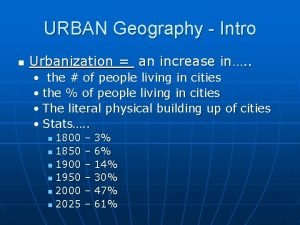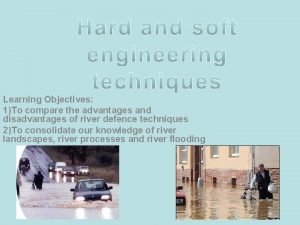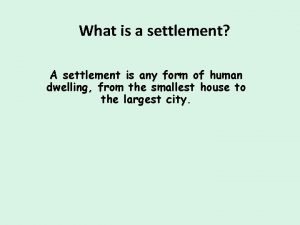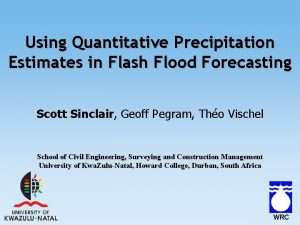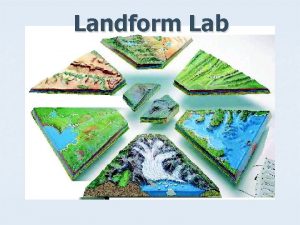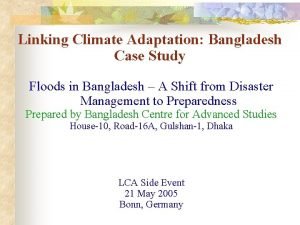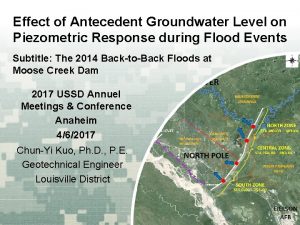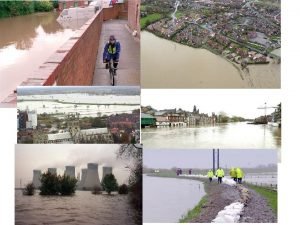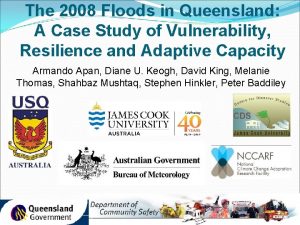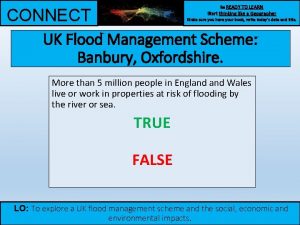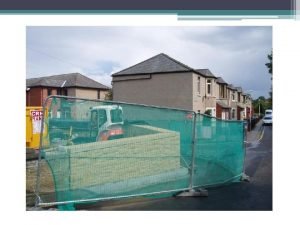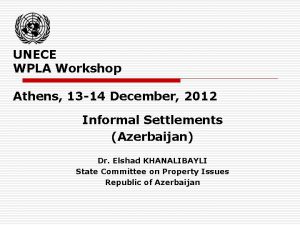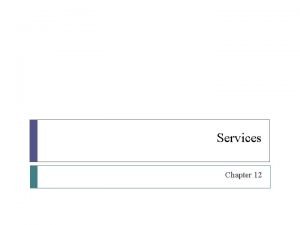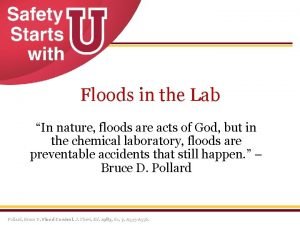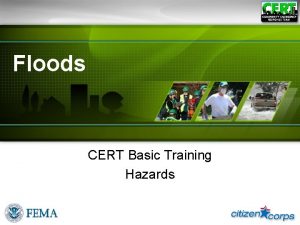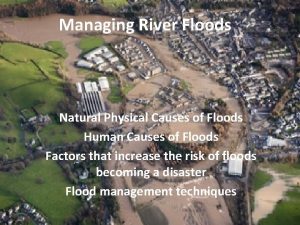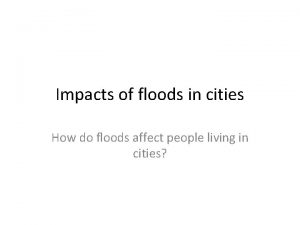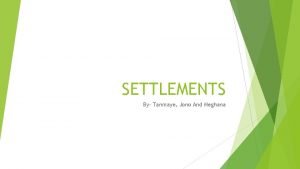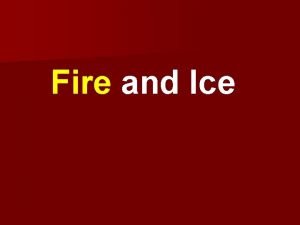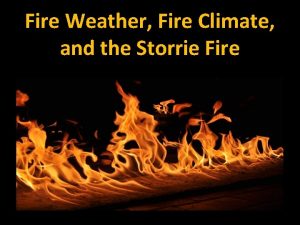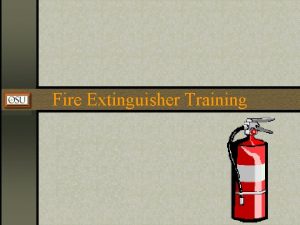CHALLENGES OF FIRE AND FLOODS IN HUMAN SETTLEMENTS






















- Slides: 22

CHALLENGES OF FIRE AND FLOODS IN HUMAN SETTLEMENTS By Department of Housing (National)

INTRODUCTION Contextualize the issue and provide the nuts and bolts, Raise issues for consideration • International experience : • communities in informal settlements are vulnerable to • environmental hazards • nature and location of the settlement • external threats from outside the settlement • Local governments : • more aware of the environmental risks • required to respond and mobilise their resources to assist such communities.

INTRODUCTION • Are urban policies are well designed enough to prevent disasters • Are adequate mechanisms in place to respond to disasters • Can sufficient resources be mobilised for post-disaster reconstruction. • Criterion for assessing disaster preparedness and responses by local authorities (DFID report, 2000) : • Are the ‘livelihoods’ of affected communities : • satisfactorily understood • supported • enhanced in the aftermath of disasters, • whether current conditions suggest that more sustainable settlements are being produced

Background Total population 44 819 780 (96 -01) population growth 2. 09% p. a. Rural 41. 83% household growth rate 4. 7% p. a. household size reduced 4. 5 to 4 ’ 96 to ‘ 01 Urban 59. 17%

Key Elements for Sustainable Human Settlements Rural Economy Space Informal Formal Governance Urban Environment

1. 45 m – 1. 84 m hh Informal settlements Urbanisation Rate 65% Rural Areas 41. 83% Urbanisation Rate 65% Informal freestanding Backyard Urban: 59% 30% new hh formulation

VULNERABILITY IN INFORMAL SETTLEMENTS • Over 12% of households living in freestanding informal housing : • most often located on the periphery of cities • experience the risks associated with • lack of services • inappropriate land for • Location • steep slopes (Inanda, Durban), • flood planes (Alexandra, Johannesburg), • close to mine dumps (East Rand, near Johannesburg), • close to heavy industrial areas (Wentworth, Durban), landfill sites settlement.

VULNERABILITY TO DISASTER • Nature of the settlement • materials utilised to build structure • prone to rapidly spreading fire (Cape Town, JHB etc) • collapsing structures. • health risks (rising damp, poor indoor air quality) • Weather factors • Living conditions



• 45 000 fires as a result of paraffin cause between 2500 – 3000 deaths pa • SA hh use more than 7000 m litres of paraffin for cooking, lighting and heating every year (SA Survey 03/04)

Addressing Disasters … • Pre and Post • Pre. . Complex, • Post. . • Responsive • Post facto

Addressing Disasters … Pre disaster * Inter-departmental collaboration – holistic approach Relevant policies Early warning systems for preparedness Accidents in the home and settlements Capacity Building * Relevant legislation and systems to get buy-in from stakeholders * Address housing, economic and social issues * Education to communities

Addressing Disasters …Post • Emergency Housing Policy • Floods 2000 Limpopo, North West, and Mpumalanga 2001 floods in the Western Cape • Constitutional Court verdict in Irene Grootboom Case • Many persons in dangerous living conditions • Informal Housing Policy • Informal settlements • In situ upgrading • Access for Emergency vehicles • Basic services, water, lighting, sanitation • Inter - Ministerial Committee

ISSUES TO BE CONSIDERED • Responses of the authorities before and when disaster strikes • How do we improve disaster awareness and preparedness? • Planning and development arms of government to combine with Departments responsible for disaster management • Need change in thinking around human settlement planning and design • Responses to disasters and management of risks must consider good planning for sustainable development • Official responses must place people in a stronger socioeconomic position • Disaster risk management and inter-departmental collaboration

Breaking New Ground - Sustainable Human Settlement • Social facilities and amenities • Housing • Safety • Economic opportunities • Viable communities • Need to Plan for Sustainable Human Settlements

Summary of Emergency Housing Policy * Temporary assistance except where formal houses are to be repaired/reconstructed * Is limited to essentials * National Norms and standards will not apply * Will augment disaster initiatives * Not an alternative for normal projects * Will accommodate wide range of beneficiaries * Should be initial phase for permanent solution

Summary of Emergency Housing Policy * Can be used where people become homeless due to situations beyond their control (floods, fires, storms, earthquakes, sinkholes, industrial incidents) * Live in dangerous conditions eg. below flood lines, on dolomite, undermined land etc

Summary of Emergency Housing Policy • Also applicable to persons who : • Live in way of services • Are evicted or threatened by eviction • Whose houses are to be demolished • Are displaced due to conflict or unrest • Live in life threatening conditions • In exceptional housing need and emergency

Summary of Emergency Housing Policy • Permanent housing solution approach should always be first option • - Application of programme : Repair Reconstruction on existing area Reconstruction in new area with services Provision of am Emergency Housing unit

Summary of Emergency Housing Policy Qualification Criteria - The normal subsidy criteria will not apply - Income may exceed R 3 500, 00 pm - Non Citizens - Minor headed households - Singles - Non first time owners - Previous beneficiaries

Thank you
 Bid rent theory example
Bid rent theory example Advantages of washlands
Advantages of washlands Rural settlement issue
Rural settlement issue Example of linear settlement
Example of linear settlement Mr. flood's party analysis
Mr. flood's party analysis Ladysmith floods 1994
Ladysmith floods 1994 Deform
Deform Bangladesh floods case study
Bangladesh floods case study Conclusion of flood
Conclusion of flood York floods 2000
York floods 2000 2008 floods mackay
2008 floods mackay Banbury floods 1998
Banbury floods 1998 Morpeth floods 2008
Morpeth floods 2008 English settlements in america
English settlements in america French east india company country
French east india company country River rock life settlements
River rock life settlements Citystate informal settlements
Citystate informal settlements Major indigenous settlements in tennessee
Major indigenous settlements in tennessee Functions of settlements
Functions of settlements European settlements in india 1498-1739
European settlements in india 1498-1739 German vikings
German vikings The basic systems and services of a city
The basic systems and services of a city European colonies in north america
European colonies in north america
